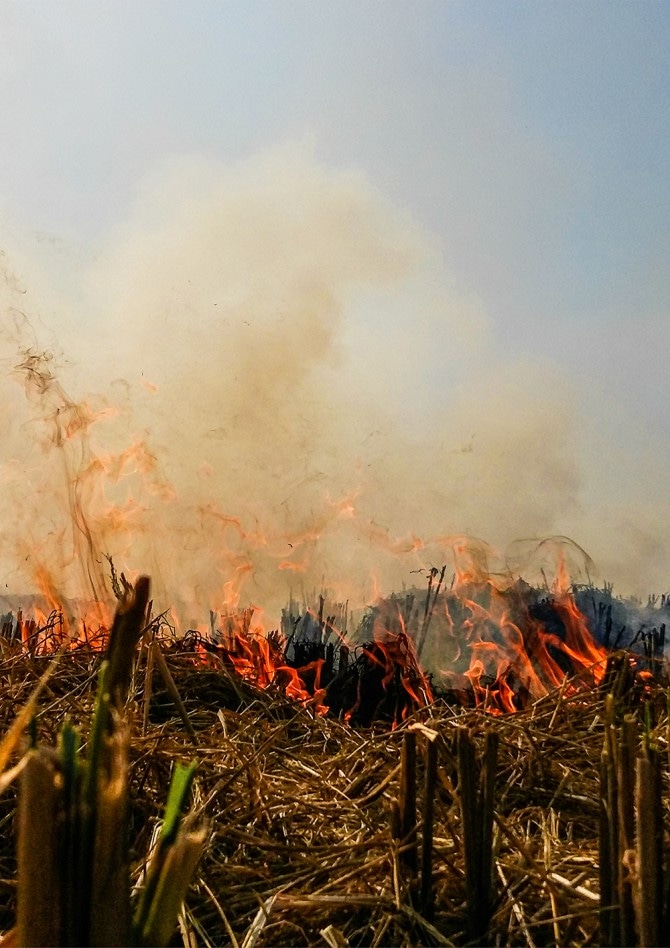Jul 31 2019
Steps to conserve groundwater in northwestern India have resulted in unanticipated consequences: Increased air pollution in an area already affected by smog and haze.
 Burning of rice straw before wheat planting in northwest India. (Image credit: Dakshinamurthy Vedachalam/CIMMYT)
Burning of rice straw before wheat planting in northwest India. (Image credit: Dakshinamurthy Vedachalam/CIMMYT)
A new research exposes how water-use policies necessitate farmers to transplant rice later in the year, which in turn stalls harvests and concentrates agricultural burnings of crop residues in November, a month when the breeze is stagnant, thereby leading to an increase in air pollution.
The perfect storm of conditions in November has produced nearly 30% higher atmospheric concentrations of fine particulate matter, tiny particles that are particularly unsafe for human health.
The study, “Tradeoffs Between Groundwater Conservation and Air Pollution From Agricultural Fires in Northwest India,” published in the June 17th of Nature Sustainability, is a partnership between researchers from Cornell and the International Maize and Wheat Improvement Center (CIMMYT).
The researchers examined groundwater conservation policies and their impact on the timing of farmers’ planting and reaping crops and burning crop residues. They also linked this information with air pollution and meteorological data.
This analysis shows that we need to think about sustainable agriculture from a systems perspective, because it’s not a single objective we’re managing for—it’s multidimensional, and solving one problem in isolation can exacerbate others.
Andrew McDonald, Study Co-Author and Associate Professor of Soil and Crop Sciences, Cornell University
Balwinder-Singh, a cropping systems simulation modeler at CIMMYT in New Delhi, India, is the first author of the paper.
Northwest India experiences two critical sustainability problems: groundwater depletion and air pollution. In 2015, nearly 1.1 million Indians died from air pollution, adding up to costs corresponding to 3% of the country’s GDP, according to the research.
Groundwater depletion is an ongoing problem, and rice cultivation is predominantly water-intensive. News reports in June provided insight into the water scarcity in Chennai, in the south; in the northwest, two groundwater conservation steps legislated in 2009 delayed the use of groundwater by farmers until later in the season. The legislation finally banned transplanting rice into paddies until after June 20th.
Using time-series satellite data from NASA, the scientists revealed that for six rice seasons before the groundwater rule was enacted; an average of 86% of the rice-growing area in the states of Haryana and Punjab was planted on or before June 28th. Less than 40% was cultivated on or before that date after the acts passed, according to the research.
Data revealed that rice harvests then shifted later, with an aggregate eight-day harvest delay in late October and early November. This shift resulted in a narrower window and a major increase in crop residue burning in the first three weeks of November. Prior to the acts, the peak date for agricultural fires was October 24th, with 490 fires daily; it was November 4th, with 681 fires daily, after the acts were enacted.
Concurrently, meteorological data showed that the first two weeks of November were basically cooler than the last two weeks of October, combined with weaker winds, causing more, stagnating air pollution in the metropolis of New Delhi, which is seriously impacted by particulate matter from these agricultural fires.
Farmers must swiftly clear residues straightaway after rice harvests in this area, referred to as India’s bread basket, to prepare fields for cultivating wheat that grows in the winter.
Solutions could consist of new agronomic technologies such as the tractor-mounted Happy Seeder, a device that enables farmers to drill through heavy crop residues and plant seeds without burning. They might combine such advances with shorter-duration rice varieties that offer flexibility in cultivating and harvesting dates.
Other options comprise investigating alternative uses for crop residues, like collecting and selling biomass for bio-char creation, power generation, or as material for furniture or paper.
There may be uses that are economically viable but they have to be considered as part of a comprehensive solution.
Andrew McDonald, Study Co-Author and Associate Professor of Soil and Crop Sciences, Cornell University
Finally, government policymakers are boosting agricultural development in northeastern India, which gains from more rain and water.
Other co-authors of the study include Amit Srivastava at CIMMYT in New Delhi and Bruno Gerard at CIMMYT in Mexico City.